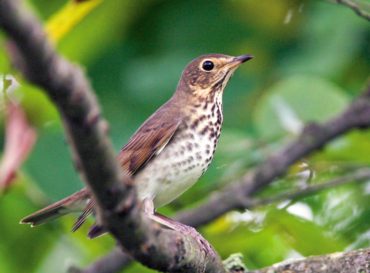
Once summer settles in, bird activity throughout the West Sound region changes. The young of most species have left the nest and are exploring their world. The adults that worked to feed and raise their families are no longer guarding territories. The bird population becomes more fluid as it moves throughout the area following the varied food supply.
Summertime is hiking time for many people. It can be an opportunity to see birds not always found in the local neighborhood. Many hikes, or walks in the woods, are easily accessible throughout this area.
Mature forests are good places to expect certain birds. Listening for their voices is the best way to find them. Some species will be heard even as you start to walk down the trail.
The Pacific wren (formerly the winter wren) is a tiny bird with a big voice. It is found in deeply shaded Northwest forests.
This tiny mite with the short stump of a tail will scold rapidly and repeatedly at any creature trespassing on its forest domain. It can be difficult to spot. Standing still, listening to its chatter, is the best way to determine the general direction the sound is coming from.
Patience will be rewarded when the wren suddenly pops into sight and perches on a nearby log, stump or tangle of undergrowth. It will throw its head back and with beak wide open, burst into voice. Some call it the “sewing-machine bird” because that is what it sounds like.
Gray jays not only greet hikers following forest trails, but they will tag along with them for a while, hoping they will break out the food. This jay has a well-known nickname. “Camp robber” describes its penchant for sharing a campers’ food. That goes for hikers too.
The jay’s voice is the opposite of the wren’s loud scolding. Gray jays communicate with soft calls back and forth to one another. It is as if they are whispering about those people on the trail.
Stop for a lunch break or a handful of trail mix and it won’t be long before gray, shadowy shapes begin drifting through the nearby trees. They have been known to snatch food away from unsuspecting victims and fly to the nearest tree to consume it. Then they are back for more.
There is one forest bird that always seems to follow anyone walking along a forest trail. Their voices alert you to their presence. Getting a good look at them is a challenge. Golden-crowned kinglets are as tiny as the winter wren.
Unlike the wren that seeks out dark areas near the forest floor, these forest dwellers flit through the trees along the path. They have high-pitched, tinkling voices and talk nonstop, like several bells ringing at the same time.
Kinglets are also insect-eaters. They feed nonstop among the tree branches while searching for tiny bugs.
Gray jays and winter wrens present a somewhat subdued look. Being gray or mostly brown, they aren’t very colorful. Kinglets are colorful. They are a greenish-gray color overall but have a broad, white eyebrow.
A black stripe borders the golden crown both birds wear. The male’s crown has an orange center. It is only seen when he flares the crown’s feathers. This occurs when he is flirting with a female or is being aggressive toward another male. It also stands up when he is bathing. Black-and-white wing-bars edge the bird’s flight feathers that are tinged with yellow.
A haunting, flute-like whistle signals the voice of the Swainson’s thrush. This “summer bird” usually arrives in the West Sound area in May. They visit suburban neighborhoods during migration but are a species that prefers the forest, especially in vegetation found along streams and rivers.
Their song is a “series of breezy, flutelike phrases, each phrase sliding upward.” It can be heard in spring and summer, early in the morning or on warm evenings shortly before sunset.
This thrush is a “skulker.” It can be hiding in nearby bushes but refuse to let you see it. Sometimes an imitation of its short, whistled call note will tempt it to look for whoever is making the sound.
This abrupt whistle says, “Whit!” It may be repeated several times before the bird begins its flute-like call. A drab, olive-brown bird, it fits into the surrounding habitat. It isn’t easy to see but its song is rewarding.
Pacific-slope flycatchers are found along streams and rivers in the same moist habitat preferred by the Swainson’s thrush. Unlike the thrush that forages closer to the ground, the flycatcher feeds higher in the forest canopy. It prefers a perch 15 to 20 feet above the ground.
Like other flycatchers, a diet of flying insects influences the bird’s choice of habitat. It will perch on a leaf-covered alder or willow, often above flowing water, and “hawk” flying insects.
Flycatchers are fast and quick. They fly out, grab dinner and return to their perch in seconds. Their drab, greenish-yellow coloring is perfect camouflage. When sitting still, surrounded by leaves, they can be impossible to see.
It is the sudden darts for food that catch your eye. If you have already heard its call, you know it is in the immediate area. The call note is a quick, sharp “p-whit or pseet.” The voice of the Pacific-slope flycatcher is one of the best ways to separate it from other flycatchers in the Empidonax family.
A summer walk to see birds is the most productive in the morning or evenings, when the sun is low on the western horizon. During the heat of the day, birds tend to seek out cool, shady areas and avoid the hot sun. This is also when they are the most active and when they are calling to one another.

























